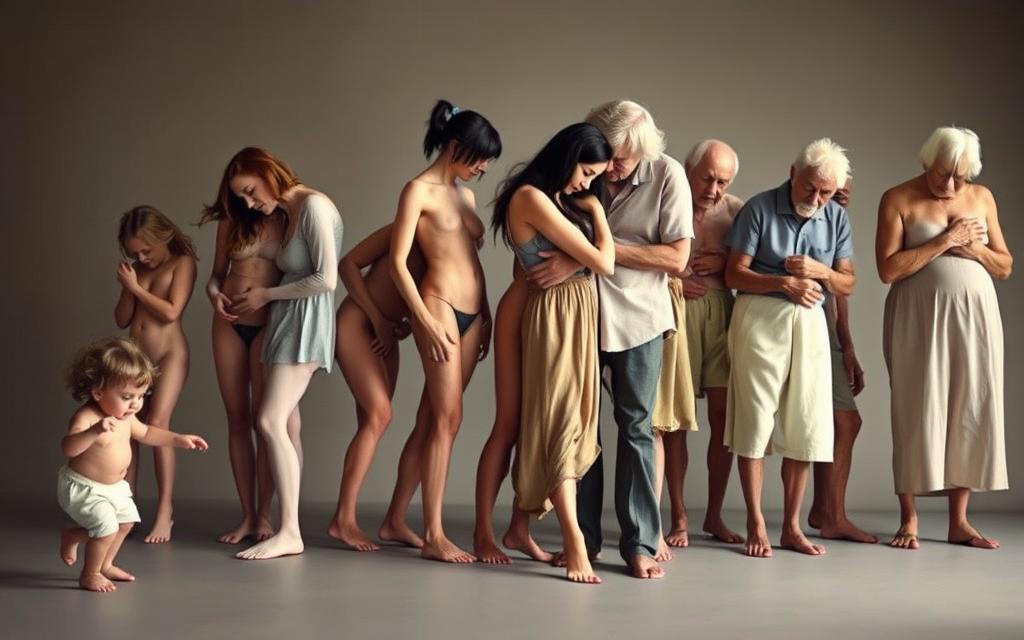Understanding our sexuality is key to our wellbeing. It’s more than just who we are; it guides us to self-acceptance. As we explore our sexual identity, we see how it shapes our lives and happiness.
Societal norms and fear of judgment can hold us back. But knowing there’s no right or wrong sexual identity helps us grow. Sexuality is important at every stage of life, from youth to old age.
The WHO says sexual health is about being physically, emotionally, mentally, and socially well. It’s not just about being disease-free. This article will explore how sexuality affects our wellbeing and why sexual health matters at all ages.
Key Takeaways
- Our sexuality significantly influences our overall wellbeing and happiness.
- Understanding sexual identity is integral to achieving emotional health.
- Sexual health is not just about the absence of issues but encompasses overall wellbeing.
- Embracing our sexual identities paves the way for self-acceptance and growth.
- Sexual health interventions can enhance knowledge and promote safer practices.
The Definition of Sexuality
Sexuality is how people express their attractions to others. This can be sexual, emotional, or physical. It includes many identities like heterosexual, homosexual, bisexual, and asexual. Each person’s identity is unique, showing the wide range of human experiences.
About 1% of people are asexual, and 10% of the LGBTQIA+ community is bisexual1. The Kinsey Scale helps show where people fall on the spectrum from straight to gay2.
Attractions can take many forms. For some, it’s both romantic and sexual. Around 20% of LGBTQIA+ people hide their true selves due to fear or societal pressure1. The LGBTQIA+ community is diverse, with many identities under the acronym Lesbian, Gay, Bisexual, Transgender, Questioning or Queer, Intersex, Asexual, and more.
Understanding Sexual Orientation
Exploring human emotions, we find that knowing about sexual orientation is key. It’s about the feelings we have for others, whether romantic, emotional, or sexual. Studies reveal that about 4.5% of adults in the U.S. identify as LGBTQIA+, showing the wide range of sexual identities3. These include being straight, gay, bi, asexual, and pansexual, each with its own unique experiences of attraction and identity.
Many people figure out their sexual orientation in their teens or early twenties, even without having had sex4. Our identities can mix and match, showing how complex attraction and personal experiences are. For example, about 1.7% of adults are bisexual, adding to the variety of sexual identities3. It’s important to know that LGBTQ people might face more anxiety and depression because of society’s bias and stigma4, with 54% of LGBTQ youth facing bullying and discrimination5.
This knowledge highlights the importance of accepting and understanding each other’s orientations. The LGBTQ community uses terms like “pansexual” and “demisexual” to describe different attractions. Each term helps us on our journey of self-discovery and growth, letting us be our true selves and embrace our diverse identities.

Gender Identity and Its Implications
Gender identity is a key part of who we are. It shows how we see ourselves in relation to gender, not just our birth sex. As society changes, we see the importance of recognizing different gender identities like transgender, non-binary, and genderqueer. For example, 59% of Gen Z think forms should offer more than just “man” and “woman” options6.
This understanding helps us be more inclusive. It lets people show their gender identity without fear.
Gender identity also affects our mental health. Being misgendered can make people feel alone and unworthy. About 35% of Gen Z know someone who uses gender-neutral pronouns, showing more acceptance6. Yet, old customs often resist changes in gender, mainly because of fear of making mistakes. This fear can stop us from talking about gender identity.
It’s important to remember that many people don’t fit into just two gender categories. Societies that see gender as a spectrum are healthier for everyone. This view is also seen in some Indigenous cultures, which have always recognized diverse gender identities7.
Our goal is to understand gender identity’s big impact on the LGBTQIA+ community. By accepting the complexity of gender, we can build stronger support systems. This leads to a more inclusive and better society for everyone.

The Impact of Sexual Health on Wellbeing
Understanding the importance of sexual health is key to enhancing our overall wellbeing. It includes physical health and emotional stability. This makes it a foundational component of a satisfying life. The COVID-19 pandemic severely disrupted essential sexual health services. This impacted access to STI testing and pre-exposure prophylaxis (PrEP), affecting lower-income populations and young individuals8.
This disruption has led to significant mental health issues linked to STIs. Conditions like syphilis and herpes simplex virus cause severe psychological distress8.
Research shows the vital connections between sexual health and other sectors. Untreated STIs can diminish an individual’s productivity and engagement in the labor market. This points to the broader economic implications of sexual health8.
The significance of sexual satisfaction should not be overlooked. It plays a crucial role in enhancing not just physical health but overall mental wellbeing. Studies show that issues related to sexual health can lead to chronic conditions like pelvic inflammatory disease and infertility. This emphasizes the importance of preventive care8.
Further, we must recognize that sexual health education varies significantly across the U.S. Only 18 states ensure that sexual education is medically accurate. Many states still emphasize abstinence or provide misleading information about sexual orientation. This creates gaps in awareness and understanding9.
This educational inconsistency can further complicate individuals’ understanding of their sexual health. It ultimately affects their wellbeing.
| Aspect | Impact |
|---|---|
| STI Prevalence | Links to chronic conditions and mental health issues |
| Access to Services | Influences on economic productivity and quality of life |
| Education Standards | Affects awareness and understanding of sexual health |
In summary, the intersections between sexual health, physical health, and our sense of sexual satisfaction play crucial roles in shaping our overall wellbeing. Enhanced awareness and access to accurate sexual health education can empower us. It allows us to make informed choices that positively affect both our physical and emotional states89.
Exploring Sexual Behavior
Understanding sexual behavior is key to grasping human sexuality. It shows how we express ourselves in relationships and experiences. Many young people see sexual content early on. For example, in the UK, 53% of kids aged 11 to 16 have seen online porn at least once10.
In the US, about 20% to 30% of kids aged 10 to 12 have seen porn too10. This can shape their views on sex and lead to risky behaviors. For instance, 10% to 18% of teens who watch porn may develop compulsive sexual behavior10.

Our sexual behavior is shaped by many factors, like our values and culture. Talking openly about sex with friends and family is crucial. It can help us make better choices and stay safe.
Early sexual experiences can be risky, leading to diseases and unwanted pregnancies. This is more common in places where kids marry young11. Talking about sex openly can help reduce stigma and encourage safer habits.
| Statistical Insights | Implications of Early Exposure |
|---|---|
| 53% of UK adolescents have seen online pornography. | Increased risk of developing unhealthy sexual norms. |
| 20% to 30% of US children aged 10 to 12 exposed to pornography. | Connection to compulsive sexual behavior in 10% to 18% of adolescents. |
| 90% of adolescents reported losing virginity before marriage. | Higher risk of STDs and unwanted pregnancies. |
| Lack of formal sex education contributes to unprotected sex. | Increased risk of unintended pregnancies and STDs. |
Sexual Development Throughout Life
Sexual development starts early in life. By age three, kids show interest in body differences12. In late childhood, about half play “Doctor” games12.
Adolescence brings big changes. Around 80% of kids notice these changes by age 9 to 1112. By 12, 90% start to understand their sexual identity12.
Teenagers, about 50%, start sexual activities12. They begin to think about contraception and safety. This is key for responsible sexual development.
Emerging adults, ages 19 to 30, make big decisions. About 70% are involved in partnership and family choices12.
Adulthood brings new challenges. Around 60% of adults aged 31 to 45 stay in long-term relationships12. About 30% manage parenting duties12.
In midlife, 40% of adults face menopause or andropause12. These changes affect sexual activity and wellbeing. Even older adults, 50% of those 65+, still have sex12. But, health issues affect 60% of this age group12.

The Role of Sexual Diversity in Society
Sexual diversity is key to creating a more inclusive society. It includes many identities, like lesbian, gay, bisexual, and transgender. By recognizing this diversity, we can build acceptance and understanding13.
The LGBTQIA+ community uses acronyms to show the variety of sexual orientations and gender identities. Each identity adds something special to our shared experience13.
Studies show that about 10% of people identify as LGBTQIA+ in some way13. Pride Parades are big events where millions celebrate sexual diversity13.
But, acceptance varies greatly. Some places are very supportive, while others discriminate. This affects the well-being of LGBTQIA+ individuals14.
For example, around 45% of LGBTQIA+ people say they face discrimination at work. This makes it hard for them to fully join society14.
| Statistic | Percentage |
|---|---|
| Individuals identifying as LGBTQIA+ | 10% |
| LGBTQIA+ youth experiencing bullying | 30% |
| Individuals feeling unsafe in schools | 75% |
| Transgender suicide rate | 40% |
Acceptance is not just good for marginalized groups. It also makes the whole community healthier. Places that welcome everyone can reduce mental health problems by up to 50% for LGBTQIA+ people14.

How Society Views Sexuality
Societal views on sexuality are shaped by cultural attitudes. These attitudes differ a lot across the United States. People often struggle with mixed messages from family, media, and friends. This makes it hard for many to figure out their own beliefs while also considering what others think15.
In our diverse society, opinions on sexuality vary. But, trying to match these views with family and cultural norms can cause inner conflict15. Young people in the U.S. deal with unwritten rules about sex. They are encouraged to think critically about the different messages they get15.
The media often shows stereotypes instead of real-life portrayals of sex. This can harm how people see relationships and sex. It reinforces bad gender roles and expectations15. Both young men and women get messages about what’s okay to do. This can lead to problems like sexual harassment and health issues15.
Worldwide, violence against women is a big problem. It affects at least 30% of women, showing how some cultures don’t value their rights16. As we talk more about sex, we also move towards equal rights. Laws allowing same-sex marriage have been passed in over 24 countries, mostly in Europe and North America16.
It’s important to recognize the double standards in sex. Young women are often judged more harshly than young men16. This can limit their choices and opportunities, holding them back from growing and facing inequality16. It’s key for both young men and women to talk openly about what’s okay in relationships. This can help create a healthier conversation about sex16.

Emotional Factors Affecting Sexuality
Emotions greatly shape our sexuality and how we connect with others. A study with 218 people, mostly women, found that stress and anxiety can lead to sexual problems. For example, 50.9% of young adults aged 18 to 23 said their feelings changed their sex drive17.
Talking openly about our feelings helps build trust and closeness. This is key in any relationship.
Our feelings greatly influence our sexual desire. Feeling good makes us want sex more, but feeling bad makes us want it less18. The study showed that measuring sexual desire is very reliable, with a score of .9818. A positive emotional state can make sex better, but negative feelings can make it worse.
Knowing how emotions affect our relationships is important. The study found that most people, 88.2%, are in monogamous relationships. This shows that emotional stability is crucial for sexual happiness. Being honest about our emotional struggles helps us support each other, leading to stronger relationships17.

Sexuality and Mental Health
Our sexuality greatly affects our mental health and overall wellbeing. Research shows that asexual people may not feel sexual attraction but still feel romantic attraction. This shows how diverse sexual identities can be19.
Discrimination against LGBTQIA+ individuals is a big problem. It’s found that 70% of them have faced such discrimination19. This can lead to more mental health issues, with LGBTQIA+ youth facing twice the risk of their straight peers19.
Medications also impact our sexual health. Many patients on certain antidepressants struggle with low sex drive or aversion to sex2021. Anxiety and depression are common and can affect our sex lives, with one-third of women experiencing decreased desire21.
It’s important to talk about both sexual and mental health. This helps create a supportive environment. Such spaces can reduce mental health risks by up to 50% for LGBTQIA+ individuals19.
Training mental health providers in sexual health is crucial. This way, they can better help patients deal with these complex issues20.

Building Self-Esteem Through Sexual Identity
Understanding and embracing our sexual identity is key to boosting our self-esteem. Studies show that those who accept their sexual orientation feel more confident and have a better self-image. This acceptance affects many areas of life, like who we choose to be with and how we protect ourselves during sex22.
When we accept ourselves, we seek out relationships that make us happy. This is crucial for our overall well-being.
Societal pressures and unrealistic body images can harm our self-esteem22. Feeling self-conscious about our bodies can make sex less enjoyable and lead to feeling disconnected from our partners. Research shows that talking openly about what we want in bed can make sex more fulfilling22.
But, many people struggle to talk about their desires, leading to dissatisfaction in their relationships.
Our early life experiences, shaped by family and culture, can leave lasting scars on our view of sex22. Accepting our bodies and sexual identities is vital for feeling good about ourselves and our sex lives22. Being part of the LGBTQ+ community can also provide much-needed support, helping us feel more accepted and positive about our sexual identity23.

Having strong social connections can greatly boost our self-esteem. Almost everyone agrees that feeling loved and valued by those close to us is essential23. By embracing our sexual identities and being part of supportive groups, we build resilience and self-worth as we journey through life.
The Benefits of Sexual Education
Sexual education is key for learning about sex, consent, and relationships. In the US, 55% of high school students have had sex by 1824. This shows why early and good sexual education is vital. People who learn about sex make safer choices, improving their health and wellbeing.
Good sexual education clears up myths about sex, including consent and relationships. For example, 18% of girls worldwide have faced child sexual abuse25. Only 9% of sexually active high school students use both condoms and birth control24.
Sex education helps by talking openly about these topics. It helps young people understand sex better and make healthier choices. For instance, it can delay when they start having sex25. Schools teaching sex education can also reduce bullying and violence, teaching consent to teens. We need more accurate and inclusive sex education, as 70% of states focus on abstinence24.
Challenges Faced by the LGBTQIA+ Community
The LGBTQIA+ community faces many challenges that affect their mental health and wellbeing. LGBTQ+ youth often have poorer mental health than their peers. They are more than twice as likely to feel suicidal and four times more likely to attempt suicide2627.
Discrimination is a big problem, with 57% of LGBTQ+ individuals facing threats or harassment because of their identity27. LGBTQ+ youth also experience more bullying and harassment in schools. This makes them feel isolated and distressed26.
Not having enough support can be very harmful. Family rejection can increase the risk of suicide for LGBTQ+ youth26. Bisexual women are more likely to experience intimate partner violence (IPV) than gay men, with 61% of bisexual women facing it in their lifetime28.
Many LGBTQ+ individuals fear discrimination and stigmatization when seeking help. Over half report facing harassment from health care providers27
Support systems are key to overcoming these challenges. Advocacy helps create safer spaces for people to be themselves without fear26. Community support and awareness can fight discrimination and improve mental health for LGBTQIA+ individuals.
Seeking Help for Sexual Health Issues
It’s crucial to address sexual health issues for our overall well-being. Many people face these concerns, often after dealing with big challenges like cancer treatment. About 40% of cancer survivors say they have sexual health problems after treatment29.
For men with prostate cancer, around 50% struggle with erectile dysfunction after treatment29. Getting help for these issues is key to improving our life quality.
Sexual dysfunction affects about 43% of women and 31% of men at some point in their lives30. Yet, 70% of people feel shy talking about these issues with doctors30. This shows how important it is to have open talks and get professional help.
Talking to therapists or joining support groups can be a safe way to discuss these topics.
But, only about 20% of patients use these resources29. Fear of what others might think can stop people from seeking help. Knowing that these issues are common can help people feel more comfortable asking for help.
By getting professional support, like therapy, many people see big improvements. About 80% of sex therapy clients say their sexual relationships get better30.
Creating Supportive Environments for All Sexualities
Creating supportive environments lets everyone feel safe and accepted. Education is key in making places like schools and workplaces welcoming. Studies show that when students see themselves in their lessons, they feel more connected and do better in school31.
It’s important to make sure everyone’s identity is respected. This helps create a friendly space for everyone31.
We should stand up for inclusivity and support diverse voices. When teachers and leaders are supportive, students have better experiences31. About 10–15% of Americans are LGBTQ+, showing we need to include their stories in our learning32.
When LGBTQ+ students feel safe, they learn more and get involved in their communities.
We can make schools safe by having rules against bullying and teaching about LGBTQ+ topics31. By being accepting, we help LGBTQ+ youth and make schools better for everyone. This is why making our spaces inclusive is so important.
Conclusion
Looking at how sexuality affects our wellbeing shows us its big impact. Accepting our sexual identities helps our mental health and relationships. It also improves how we connect with others in our communities33.
It’s clear that we need more acceptance and support for sexual minorities. They face higher rates of depression, anxiety, and substance abuse34. Understanding and celebrating different sexual identities can make us feel more connected33.
We must create spaces where everyone feels valued and understood. The stigma faced by non-heterosexual and transgender people is a big issue34. With support and open conversations, we can break down these barriers. This way, everyone can live their lives authentically and healthily.
Our dedication to sexual health rights and understanding identity is key. It helps us move towards acceptance together. By exploring the complexities of sexuality, we improve our wellbeing and build healthier communities35.
FAQ
What is the definition of sexuality?
Sexuality is about our feelings and actions towards others. It shows who we are and how we feel. It includes being straight, gay, bi, or asexual, showing how different we all are.
How does sexual orientation influence our lives?
Our sexual orientation shapes who we are and our relationships. Knowing our orientation helps us grow and feel good about ourselves.
What is gender identity?
Gender identity is how we feel about our gender, which might not match our birth sex. It’s important to accept all genders to make our world more welcoming.
How does sexual health impact our overall wellbeing?
Our sexual health affects our body and mind. Good health means we’re happy and healthy in our relationships. Bad health can cause problems in our feelings and with others.
What are sexual behaviors, and why are they important?
Sexual behavior is how we show our feelings through actions with others. Knowing our behavior helps us have better relationships and talk openly with our partners.
What does sexual development entail?
Sexual development is about growing up and understanding our feelings and bodies. It includes puberty, adult relationships, and how we change as we get older.
Why is sexual diversity important in society?
Sexual diversity celebrates all kinds of feelings and identities. Accepting everyone helps us all feel included and valued, making society better for everyone.
How does society view sexuality?
People see sex differently based on culture, religion, and society. Understanding these views helps us fight stereotypes and talk openly about sex.
What emotional factors affect our sexuality?
Feelings like sadness, worry, and stress can change how we feel about sex. Knowing this helps us build better relationships and feel good about ourselves.
How does sexuality relate to mental health?
Sexuality deeply affects our mental health and how we see ourselves. Stigma and discrimination can make us feel alone. It’s key to create supportive spaces.
How can one build self-esteem through sexual identity?
Loving who we are helps us feel better about ourselves. Support from friends and community helps us face challenges and feel confident, leading to healthier relationships.
What are the benefits of comprehensive sexual education?
Good sex education teaches us about consent, relationships, and our bodies. It helps us make smart choices and understand our and others’ needs.
What challenges does the LGBTQIA+ community face?
The LGBTQIA+ community faces discrimination, harassment, and stigma. Understanding these issues helps us support and advocate for their rights, promoting acceptance and empathy.
When should one seek help for sexual health issues?
If we face sexual health problems, seeking help is crucial. Healthcare providers, therapists, and support groups can improve our sexual wellbeing and overall health.
How can we create supportive environments for all sexualities?
Creating welcoming spaces means educating and being an ally. By celebrating diversity, we promote acceptance and understanding, improving everyone’s wellbeing.
Source Links
- 46 Terms That Describe Sexual Attraction, Behavior & Orientation – https://www.healthline.com/health/different-types-of-sexuality
- Types of sexuality and their definitions – https://www.medicalnewstoday.com/articles/types-of-sexuality
- Understanding Sexual Orientation | JED – https://jedfoundation.org/resource/understanding-sexual-orientation/
- An Overview of Sexual Orientation – https://www.webmd.com/sex-relationships/sexual-orientation
- Understanding and Identifying Sexual Orientations – https://health.clevelandclinic.org/types-of-sexual-orientation
- How the gender identity revolution impacts society – https://news.temple.edu/news/2021-08-04/how-gender-identity-revolution-impacts-society
- Why Gender Identity and Sexuality Aren’t Mutually Exclusive | BestColleges – https://www.bestcolleges.com/blog/understanding-gender-identity-and-sexuality/
- Exploring the wider societal impacts of sexual health issues and interventions to build a framework for research and policy: a qualitative study based on in-depth semi-structured interviews with experts in OECD member countries – https://pmc.ncbi.nlm.nih.gov/articles/PMC9843221/
- Understanding Sexual Health – https://www.ashasexualhealth.org/sexual-health/
- Normal Versus Abnormal Sexual Behavior in Adolescents – https://www.psychiatrictimes.com/view/normal-versus-abnormal-sexual-behavior-adolescents
- Understanding normal development of adolescent sexuality: A bumpy ride – https://pmc.ncbi.nlm.nih.gov/articles/PMC4477452/
- Sexuality lifespan | Island Sexual Health – https://www.islandsexualhealth.org/sexual-identity/lifespan/
- Sexual diversity – https://en.wikipedia.org/wiki/Sexual_diversity
- Sexual orientation, gender identity and gender expression – https://www.fraserhealth.ca/health-topics-a-to-z/school-health/sex-education-and-sexual-identity/gender-and-sexual-identity-in-schools
- 09-Sexuality and Society – https://siecus.org/wp-content/uploads/2015/07/Sexuality-and-Society.pdf
- Sexuality and Culture – https://open.maricopa.edu/culturepsychology/chapter/sexuality-and-culture/
- The effects of sexual shame, emotion regulation and gender on sexual desire – https://pmc.ncbi.nlm.nih.gov/articles/PMC10006235/
- Effects of emotional state on sexual desire and sexual dysfunction – Motivation and Emotion – https://link.springer.com/article/10.1007/BF00992203
- Sexuality and mental health | Understanding Your Sexuality – https://www.youngminds.org.uk/young-person/coping-with-life/sexuality-and-mental-health/
- Sexuality and Mental Health: The Need for Mutual Development and Research – https://pmc.ncbi.nlm.nih.gov/articles/PMC6912629/
- Integrating Mental and Sexual Health – https://www.news-medical.net/health/Integrating-Mental-and-Sexual-Health.aspx
- Sexual Self-Esteem: A Short Course – https://www.huffpost.com/entry/sexual-selfesteem-a-short_b_11079260
- Self-esteem in sexual minority young adults: a qualitative interview study exploring protective factors and helpful coping responses – https://pmc.ncbi.nlm.nih.gov/articles/PMC9519121/
- The Importance of Access to Comprehensive Sex Education – https://www.aap.org/en/patient-care/adolescent-sexual-health/equitable-access-to-sexual-and-reproductive-health-care-for-all-youth/the-importance-of-access-to-comprehensive-sex-education/?srsltid=AfmBOor-3wZJOOXKaCM6JDuTkGK2ejTEcEEjgu1jfobLGMtbnzDy2h5-
- Comprehensive sexuality education – https://www.who.int/news-room/questions-and-answers/item/comprehensive-sexuality-education
- LGBTQ+ Inclusion and Support: An Analysis of Challenges and Opportunities Within 4-H – https://pmc.ncbi.nlm.nih.gov/articles/PMC8916108/
- LGBTQ+ Communities and Mental Health – https://www.mhanational.org/issues/lgbtq-communities-and-mental-health
- Understanding Intimate Partner Violence in the LGBTQ+ Community – https://www.hrc.org/resources/understanding-intimate-partner-violence-in-the-lgbtq-community
- Common Sexual Health Problems and Who Can Help – https://www.cdc.gov/cancer-survivors/healthy-living-guides/common-sexual-health-problems.html
- Sex Therapist: What They Do and When To See One – https://my.clevelandclinic.org/health/articles/24524-sex-therapist
- 5 Ways Educators Can Help Support LGBTQ+ Students – https://www.tc.columbia.edu/articles/2022/october/5-ways-educators-can-help-support-lgbtq-students/
- Fourteen Recommendations to Create a More Inclusive Environment for LGBTQ+ Individuals in Academic Biology – https://pmc.ncbi.nlm.nih.gov/articles/PMC8711824/
- 6 areas of research that offer fascinating conclusions on sexuality – https://blog.ted.com/6-studies-that-offer-fascinating-conclusions-about-human-sexuality/
- Conclusion – Sexuality and Gender – https://www.thenewatlantis.com/publications/conclusion-sexuality-and-gender
- Conclusion – Queer Livability – NCBI Bookshelf – https://www.ncbi.nlm.nih.gov/books/NBK592442/
